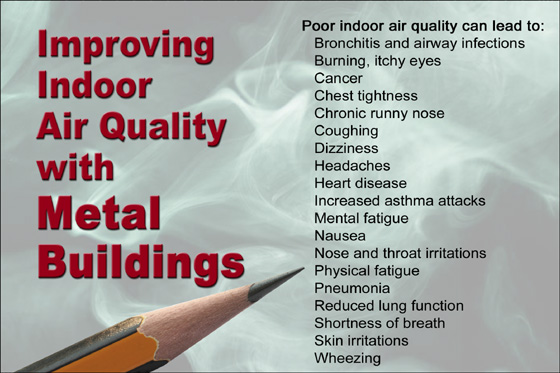The Inside Story on Indoor Air Quality
Building a safe, healthy structure means limiting indoor air pollutants. Constructing metal buildings helps generate the freshest inside air possible.
Why Is Indoor Air Quality So Important?
 Most Americans now spend 90% of each day indoors. The very young, the very old, and those with respiratory ailments— who are most susceptible the effects of indoor pollution— probably stay indoors even more.
Most Americans now spend 90% of each day indoors. The very young, the very old, and those with respiratory ailments— who are most susceptible the effects of indoor pollution— probably stay indoors even more.
The facts are frightening:
- Inside air may be two to five times more polluted than the outside atmosphere, according to the U.S. Environmental Protection Agency (EPA).
- In a newly constructed building, indoor pollution levels rise up to 100 times more than outdoors, as building materials and furnishings outgas.
- An adult inhales 3,000 gallons of air daily. Children inhale 50% more air per pound of body weight than adults. The more polluted the air (and the longer the exposure) the greater the risk of compromising health.
- An indoor pollutant is 1,000 times more likely to penetrate the lungs than an outdoor contaminate, says The World Health Organization (WHO).
- Buildings today are better insulated and more airtight than in the past, purposely reducing indoor/outdoor air exchange to conserve energy. Consequently, pollutants multiply in the structure.
- New construction often includes adhesives, cabinets, carpets and floor coverings, ceiling tiles, composite wood products, draperies, furniture, paints, sealants, wall coverings, and other materials which outgas volatile organic compounds (VOCs). Add in cleaning products, cooking, disinfectants, mold, pets, smoking, and soon people are sucking in a toxic cocktail with every breath.
- The first year after construction produces the highest level of indoor pollutants. However, many products continue releasing airborne toxins for years.
- VOCs can cause severe asthma attacks, cancers, damage to vital organs, headaches, incoordination, nausea, and eye, nose, and throat irritation; headaches, loss of coordination, nausea, and damage to liver, kidney, and central nervous system.
- The EPA describes “sick building syndrome” (SBS) as a structure within which people chronically experience health problems without any identifiable source.
Combating Indoor Air Pollution with Metal Buildings
The choice of building products makes a huge difference in the quality of the indoor air. For example, choosing metal buildings eliminates many potential pollutants:
- As an inorganic material, steel never outgasses or releases VOCs.
- Steel is impervious to termites and requires no harsh chemical treatments.
- Inorganic steel neither promotes nor feeds mold spores or mildew.
- Unlike engineered wood products, steel contains no adhesives or formaldehyde-based glues to outgas and contaminate indoor air quality.
- As an inorganic, steel contains no respiratory allergens.
Other Health Benefits from RHINO
RHINO’s steel building systems make stronger, safer, healthier structures. Our metal buildings out-perform other types of structures during earthquakes, fires, and violent storms. And RHINO’s Pro-Value insulation system even reduces outside noise, for a much quieter indoor environment.
Learn more by calling RHINO now for details on your next commercial, industrial, or personal building project. The RHINO phone number is 940.383.9566.
